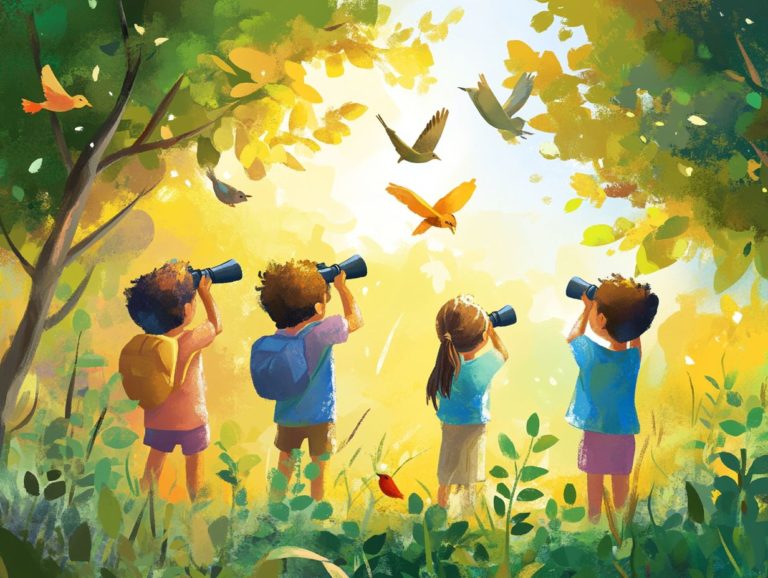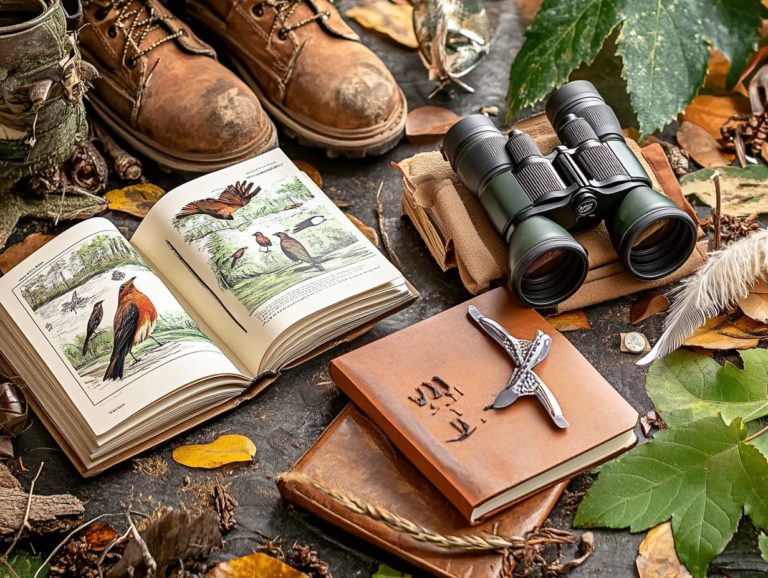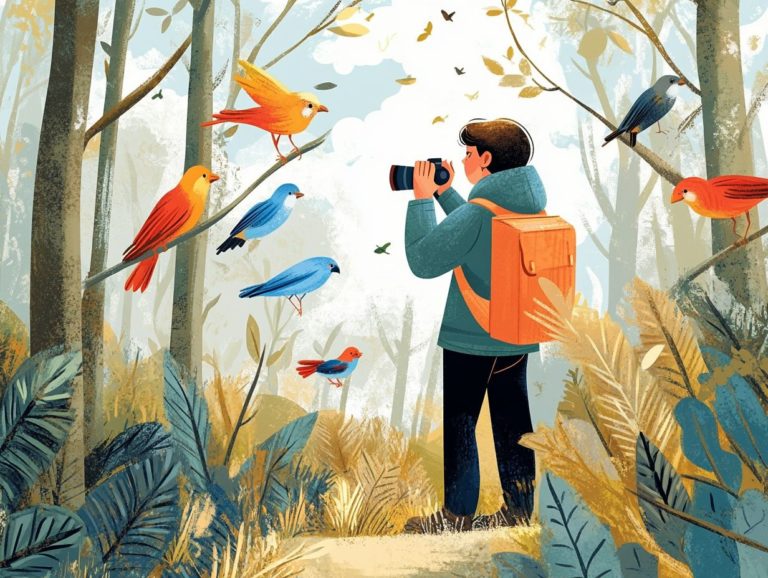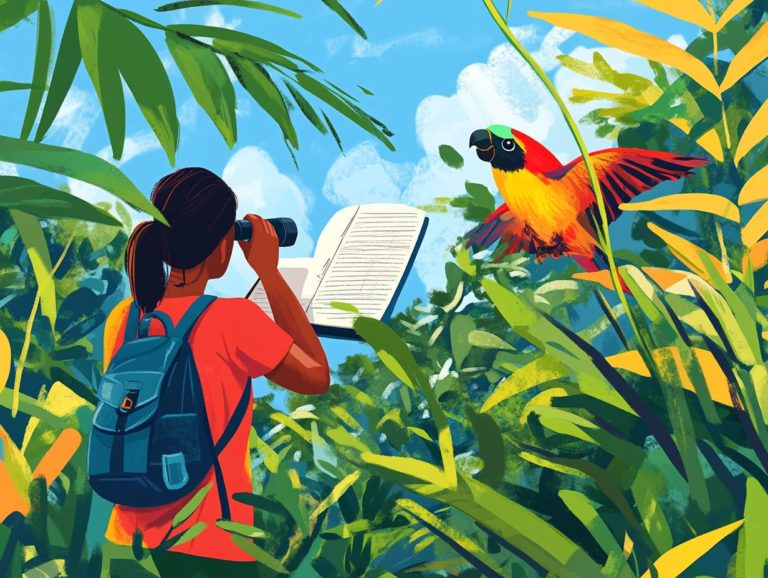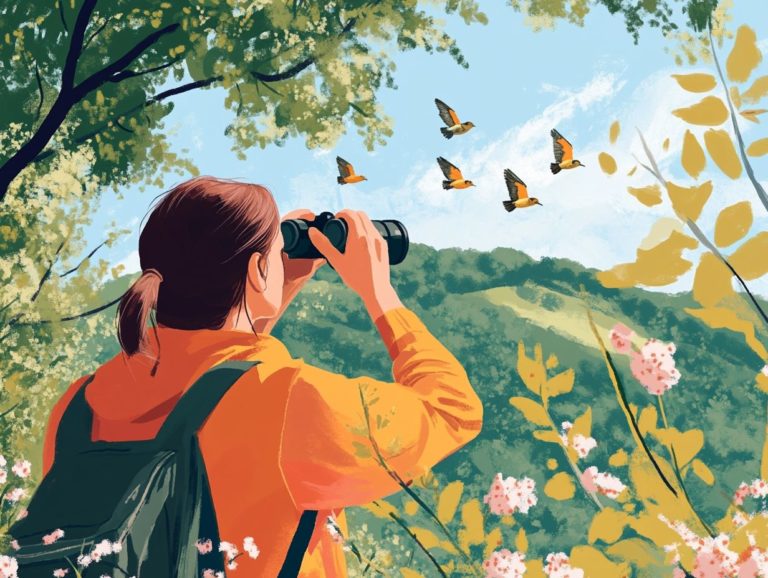What Are the Best Practices for Bird Watching During Migration?
Bird migration is a captivating natural phenomenon that enchants both bird enthusiasts and casual observers. Understanding the complexities of this journey deepens our appreciation for these remarkable creatures and is important for conservation efforts.
This article delves into the essentials of bird migration, its significance for conservation and research, and offers best practices for observing these avian travelers.
From identifying common migratory species to tips for capturing stunning photographs, get ready to experience the thrill of birdwatching during migration season!
Contents
- Key Takeaways:
- Understanding Bird Migration
- Why is Birdwatching During Migration Important?
- Best Practices for Birdwatching During Migration
- How to Identify Migratory Birds
- Tips for Photographing Migratory Birds
- Frequently Asked Questions
- What Are the Best Practices for Bird Watching During Migration?
- Why is Choosing the Right Location Important for Bird Watching During Migration?
- How Can I Minimize Disturbance to the Birds During Migration?
- What Are Some Ethical Guidelines for Bird Watching During Migration?
- Is It Safe to Observe Birds During Migration?
- What Should I Bring with Me for Bird Watching During Migration?
Key Takeaways:
- Bird migration is the seasonal movement of birds from one place to another, usually for breeding or food sources.
- Birdwatching during migration is crucial for conservation and research efforts, as it allows for monitoring population trends and distribution of species.
- To participate in birdwatching during migration, it is important to choose the right location and time, have appropriate equipment, and follow proper behavior and etiquette towards the birds.
Understanding Bird Migration
Bird migration refers to the seasonal movements of birds between different habitats in search of food, breeding grounds, and suitable climates. This phenomenon primarily occurs during the spring and fall and involves various bird species.
Migration patterns are influenced by factors such as weather, food availability, and genetics. Organizations like Audubon New York and the Cornell Lab of Ornithology study these migration patterns.
Their research enhances our understanding of the behaviors and habitats of migratory birds, which can improve birdwatching efforts and support conservation initiatives.
What is Bird Migration?
Bird migration refers to the regular seasonal movement of bird species between their breeding and wintering grounds, often guided by natural behaviors and environmental cues. This remarkable phenomenon not only highlights the extraordinary navigational abilities of these avian creatures but also helps their survival and reproductive success.
Many bird species, such as the Arctic Tern and the Swallow, embark on extensive journeys, often covering thousands of miles to reach their optimal habitats. These seasonal migrations are essential for maintaining ecological balance, as they facilitate pollination, seed dispersal, and pest control.
The varied environments sought by migratory birds—ranging from wetlands to forests—contribute to the biodiversity of both their breeding and wintering locations, showcasing the intricate connections within ecosystems.
Why is Birdwatching During Migration Important?
Birdwatching during migration is significant as it enables enthusiasts to observe a diverse array of species that are typically not found in their region. It is also important because it enhances our understanding of birds’ behaviors and migration patterns.
Benefits for Bird Conservation and Research
Birdwatching during migration provides valuable data on the health and status of various species, such as the Great Crested Flycatcher and Eastern Screech-Owl, which is crucial for their conservation and research tracking.
By studying migratory birds, birdwatchers enhance our understanding of changing migratory patterns resulting from climate change and habitat destruction. This knowledge is essential for the scientific community and informs the creation of conservation strategies aimed at protecting these species.
Citizen science plays a vital role in this effort, enabling a wide range of individuals to collect and share important data about migration timing and frequency. These grassroots movements raise awareness of the ongoing threats faced by these populations and lead to protective measures that can help ensure the survival of at-risk species.
Best Practices for Birdwatching During Migration
Implementing best practices for birdwatching during migration enhances the experience for both observers and the birds. These practices allow enthusiasts to appreciate the wonder of migration while minimizing harm to bird habitats.
Join us this migration season and witness the incredible journey of our feathered friends!
Location and Timing
The location and time of year are crucial for successful bird watching.
This is especially true during migration periods when certain areas host large concentrations of specific species.
The selection of these sites is influenced by geography. Areas like wetlands, forests, and coastal regions provide essential habitats and resources for migratory birds.
The Atlantic Flyway, along the eastern coast of the United States, is a popular spring destination for bird watchers. Here, they hope to observe songbirds returning from their winter habitats.
Local bird watchers are invaluable resources, providing insights into the best times to visit and which species are currently migrating through the area.
Equipment and Gear
Using the right gear makes birdwatching more enjoyable and helps you easily spot different bird species.
Essential tools include binoculars, field guides, and apps like Merlin.
The type of binoculars used is particularly important. They allow enthusiasts to spot distant birds, making identification easier and more fun.
Field guides are great tools that provide descriptions, habitat information, and images to help recognize different species in their natural environments.
In recent years, mobile apps have simplified the identification process with features like sound recognition and instant information.
Moreover, bird feeders can transform local yards and gardens into vibrant centers for bird watching. They attract migratory birds and enhance the overall experience.
These feeders also provide essential food sources, creating an engaging atmosphere for bird watchers to connect more deeply with nature.
Behavior and Etiquette
Knowing the right behavior and etiquette makes birdwatching even more enjoyable!
It’s essential for the safety of bird species and their habitats, as well as for fostering respectful interactions between local birders and wildlife.
The most important aspect of etiquette is maintaining a safe distance from birds. This protects nests and prevents disturbance during critical feeding and breeding times.
It’s also important to be mindful of noise levels; quiet conversations enhance the experience for both fellow birders and the birds themselves.
Minimizing disturbances in natural settings can significantly enrich one’s enjoyment and connection with the natural world.
Adhering to best practices in birdwatching etiquette is vital for conservation. It helps create an environment where species can thrive without interference, benefiting both observers and the ecosystem.
How to Identify Migratory Birds
Identifying migratory birds is an enjoyable and rewarding experience. Resources like the Sibley Backyard Birding Flashcards can assist in recognizing various species.
Common Species and Their Characteristics
Several migratory bird species are frequently observed during migration seasons. These include the Blackpoll Warbler, Yellow Warbler, and American Robin, each with distinct characteristics that make them easy to identify.
The Blackpoll Warbler is known for its remarkable long migrations, traveling over 2,400 miles between its breeding grounds in North America and wintering grounds in South America.
Its distinctive black cap and bold white underparts make it easily recognizable.
The Yellow Warbler typically favors moist habitats, such as willow thickets and wetlands. It is easily identified by its bright yellow plumage and sweet song.
The American Robin is a familiar sight in backyards across North America, easily recognized by its orange-red breast and cheerful demeanor.
Identifying birds by their physical traits, songs, or preferred environments can dramatically enhance your chances of spotting them in the wild.
Tips for Photographing Migratory Birds
Capturing photographs of migratory birds requires a blend of technique, patience, and the right equipment. This helps effectively showcase their unique behaviors and natural habitats.
Techniques for Capturing the Best Shots
Capture breathtaking images of migratory birds with these essential photography techniques! Using the right methods can lead to stunning photos that beautifully showcase these birds in their natural environment.
Key factors for enhancing image quality include:
- Lighting: The best times to shoot are during the early morning or late afternoon, often referred to as the “golden hour.” This period provides softer shadows and richer colors. The angle of light helps manage backlighting when birds are flying toward the camera.
- Shutter Speed: A fast shutter speed is crucial for producing crisp images of birds in flight. Don’t miss your chance to capture stunning moments—use a fast shutter speed for the ultimate clarity!
- Composition: Use the rule of thirds, a way to make your photos more interesting by placing subjects off-center, to create visual interest within the frame.
- Focusing: The eyes of the birds often serve as the most effective focal point, naturally drawing the viewer’s attention.
For capturing stunning images of migratory birds, certain equipment is particularly useful:
Essential Equipment
- Telephoto Lens: This allows for photographing from a distance, which is crucial since birds can be skittish and may flee if approached too closely.
- Sturdy Tripod or Monopod: A sturdy tripod minimizes camera shake, making your shots clearer, especially when using a long lens.
- High-Quality Camera with a High Frame Rate: This feature is beneficial for capturing fleeting moments, such as when migratory birds take off.
Frequently Asked Questions
What Are the Best Practices for Bird Watching During Migration?
Consider using black oil sunflower seed feeders or Morning Song Birdwatcher’s Blend to attract birds during their migration. The best practices for bird watching include:
- Choosing the right location
- Minimizing disturbance to the birds
- Following ethical guidelines
Why is Choosing the Right Location Important for Bird Watching During Migration?
Choosing the right location increases your chances of spotting a variety of bird species during migration. Look for areas with diverse habitats and food sources.
How Can I Minimize Disturbance to the Birds During Migration?
To minimize disturbance, avoid getting too close to the birds or their nesting areas. Use binoculars or a zoom lens instead. Also, avoid loud noises or sudden movements.
What Are Some Ethical Guidelines for Bird Watching During Migration?
Some ethical guidelines include:
- Not disturbing the birds or their habitats
- Not feeding or touching the birds
- Respecting private property
It’s also important to follow any rules or regulations for the specific location.
Is It Safe to Observe Birds During Migration?
Yes, it is safe to observe birds during migration as long as you follow safety precautions. Stay on designated paths, wear appropriate clothing and gear, and watch out for potential hazards like steep cliffs or rough terrain.
What Should I Bring with Me for Bird Watching During Migration?
It is recommended to bring:
- Binoculars
- A field guide
- Water
- Sunscreen
- Insect repellent
Dressing in layers and wearing comfortable shoes for walking is also a good idea.

